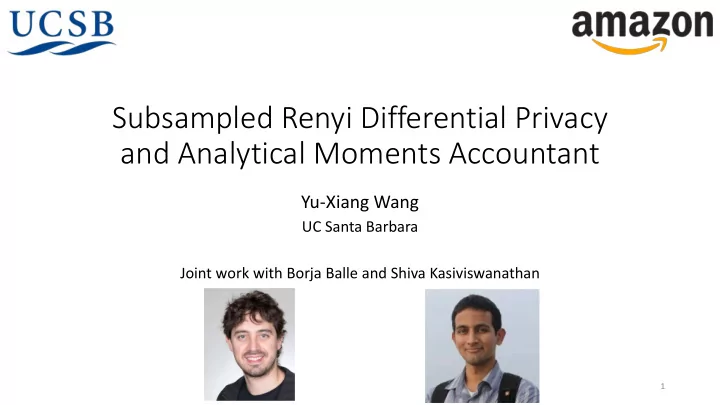

Subsampled Renyi Differential Privacy and Analytical Moments Accountant Yu-Xiang Wang UC Santa Barbara Joint work with Borja Balle and Shiva Kasiviswanathan 1
Outline • Preliminary: • Algorithm-specific privacy analysis and Renyi DP • Privacy amplification by subsampling • Renyi DP of Subsampled Algorithms • Composition and Analytical moments accountant 2
Renyi DP and algorithm-specific DP analysis • Ɛ-DP is a crude summary of the privacy guarantee • RDP (Mironov, 2017) and characterizes the full-distribution of the privacy R.V. induced by a specific algorithm • Also closely related to CDP (Dwork & Rothblum,2016) and zCDP (Bun & Steinke,2016) 3
Subsampled Randomized Algorithm Output Algorithm M 4
Example: The Noisy SGD algorithm (Song et al. 2013; Bassily et. al. 2014) • Randomly chosen minibatch (Subsampling) • Then add gaussian noise (Gaussian mechanism) • RDP analysis for subsampled Gaussian mechanism (Abadi et al., 2016) • Really what makes Deep Learning with Differential Privacy practical. 5
More general use of subsampling in algorithm designs • Ensemble learning with Bagging / Random Forest (Breiman) • Bootstraps, Jackknife, subsampling bootstrap (Efron; Stein; Politis and Romano) • Sublinear algorithms in exploratory data analysis • Sketching • Property testing 6
Privacy “amplification” by subsampling Subsampling Lemma: If M obeys (Ɛ,δ)-DP, then M ⚬ Subsample obeys that (Ɛ’,δ’)-DP with • First seen in “What can we learn privately?” (Kasiviswanathan et al., 2008) • Subsequently used as a fundamental technical tool for learning theory with DP: • (Beimel et al., 2013) (Bun and , 2015) (Wang et al., 2016) • Most recent “tightened” revision above in: • Borja Balle, Gilles Barthe, Marco Gaboardi (NeurIPS’18) 7
This work: Privacy amplification by subsampling using Renyi Differential Privacy • Can we prove a similar theorem for RDP? • Laplace mech., Randomized responses, posterior sampling and etc. • New tool in DP algorithm design. • Tight constant. 8
A subsampled mechanism samples from a mixture distribution with many mixture components! • X’ <- Subsample(X) • h <- f(X’) + Noise 9
Changing to an adjacent data set • X’ <- Subsample(X) • h <- f(X’) + Noise 10
Main technical results Theorem (Upper bound): Let M obeys (α ,Ɛ(α))-RDP for all α. Then M(subsample( DATA)) obeys Theorem (lower bound): Let M satisfies some mild conditions 11
Numerical evaluation of the bounds 12
New techniques in the proof • Moments of Linearized Privacy loss R.V. • discrete difference operators ---- continuous derivative operators • Newton series expansions ----- Taylor series • Ternary Pearson-Vajda divergences. • Natural for handling subsampling. 13
Analytical moments accountant Gaussian mechanism Ɛ = ?, δ = 1e-8 Subsampled Laplace RDPacct … … Randomized response • Tracking RDP for all order as a symbolic function • Numerical calculations for (Ɛ, δ)-DP guarantees. • Automatically DP calculations for complex algorithms. • Enable state-of-the-art DP for non-experts. 14
Using our bounds for advanced composition 15
Take-home messages and future work 1. The first generic subsampling lemma for RDP mechanism. 2. Stronger composition than advanced composition • Future work: • Closing the constant gap in the upper/lower bounds • Other types of subsampling (e.g., Poisson subsampling) • Other types of privacy amplification in RDP Wang, Y. X., Balle, B., & Kasiviswanathan, S. (2018). Subsampled R\'enyi Differential Privacy and Analytical Moments Accountant. arXiv preprint arXiv:1808.00087 . Open source software will be released soon! Stay tuned. 16
Thank you for your attention! 17
Recommend
More recommend